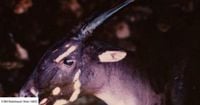In a remarkable scientific breakthrough, researchers have fully deciphered the genome of the elusive Saola, often referred to as the "Asian unicorn" due to its rare and mythical status. Last observed in 2013, this ghostly creature from the mountains of Southeast Asia may already be extinct, but the new genetic insights could pave the way for its potential revival.
Officially discovered in 1992 in the Annamite Range between Laos and Vietnam, the Saola (Pseudoryx nghetinhensis) is a unique bovine that has been isolated evolutionarily for 12 to 15 million years, making it a living relic of a bygone era. With its long parallel horns and delicate features, the Saola is often compared to an antelope. Unfortunately, its population has dwindled to critically low numbers, with the International Union for Conservation of Nature (IUCN) estimating that fewer than 100 individuals may remain, or possibly none at all.
The recent study published in the journal CELL highlights the successful sequencing of the complete genome of 26 Saolas, a feat achieved using genetic material collected from hunter communities. This groundbreaking work has revealed significant genetic differences within the Saola population, which is divided into two distinct groups. According to Genís Garcia Erill, a former PhD student in the Department of Biology at the University of Copenhagen, "We were quite surprised to discover that the Saola is divided into two populations showing significant genetic differences. This split dates back between 5,000 and 20,000 years, which was completely unknown before, and there was no way to know without genetic data."
This finding opens up new avenues for conservation efforts. Rasmus Heller, a co-author of the study, explained, "If we can gather at least a dozen Saolas—ideally a mix of the two populations—to form the basis of a future population, our models show that the species would have a reasonable chance of long-term survival." This approach could restore the genetic diversity necessary for the Saola's continued existence.
However, the question remains: are there any Saolas still alive today? Nguyen Quoc Dung from the Vietnam Forest Inventory Institute notes that the existence of living Saolas cannot currently be confirmed. "For over a decade, no camera traps or DNA evidence have been able to verify their existence with certainty," he remarked. This lack of evidence has posed a significant challenge for researchers trying to locate this elusive species.
In light of the new genomic data, researchers are optimistic about their chances of finding the Saola. Minh Duc Le from the National University of Vietnam stated, "Many researchers have unsuccessfully tried to find traces of Saola using methods such as environmental DNA from water or even leeches. Now that we know the complete genome of the Saola, our toolkit has expanded significantly." This advancement could enhance their efforts to locate the Saola in its natural habitat.
Moreover, the implications of this genetic research extend beyond mere conservation. The study suggests that the genomic data could one day be utilized in de-extinction efforts. Rasmus Heller pointed out, "Our results could theoretically be used if we manage to bring back the Saola through de-extinction technologies." This perspective evokes comparisons to the recent recreation of dire wolves—giant wolves from North America that disappeared over 10,000 years ago—using ancient DNA and targeted genetic modifications.
The Saola's plight underscores the broader challenges facing many endangered species today. Habitat loss, poaching, and the ongoing destruction of forests in Southeast Asia have drastically reduced their populations. The urgency to act is paramount, as the Saola's existence hangs in the balance. Conservationists argue that the genetic insights gained from this study could be crucial in developing effective strategies to save not only the Saola but also other endangered species facing similar threats.
As researchers continue to explore the genetic makeup of the Saola, they remain hopeful that these findings will lead to actionable conservation efforts. The potential for reviving the Saola from the brink of extinction is not just a scientific challenge but a moral imperative. The story of the Asian unicorn is far from over, and with continued dedication and innovation, the dream of seeing this magnificent creature roam the forests of Southeast Asia again could become a reality.
In summary, the complete sequencing of the Saola's genome offers a glimmer of hope for the survival of this critically endangered species. By understanding its genetic diversity and potential for population recovery, scientists are laying the groundwork for a future where the Saola may once again thrive in its natural habitat. The journey to save the Saola is just beginning, and the world watches with bated breath.

